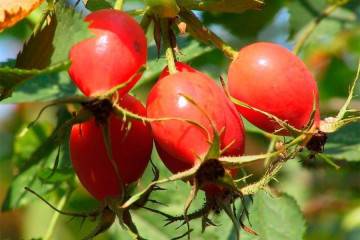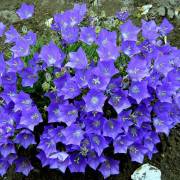How to distinguish a rose from a rose hip by leaves
Content:
Rose and rose hips are members of the Rosaceae family and have many similarities. Often unscrupulous sellers give out wild rosehip seedlings for expensive varieties of roses. In order not to be mistaken in the choice, it is important to be able to understand plants and know how to distinguish a rose from a wild rose.
How to determine if a rose or rosehip is growing on a site
It is easy to recognize 2 species during flowering: the flowers of the rose are fluffy, multi-petaled, the inflorescence of the rose hips consists of 5 petals.
What is the difference between a rose and a rosehip
Rosehip and bush rose have a lot in common. Similar signs:
- deciduous shrubs with erect shoots;
- there are climbing species;
- the root system is powerful pivotal, it goes 40 cm deep;
- the height of the bushes from 1.5 m;
- shoots with thorns;
- leaves are long pinnate;
- ovoid leaf plate with serrated edges.
Plants can be distinguished by many factors, but it will be difficult for a novice florist to do this. In order not to be mistaken and buy a varietal plant, when buying, they pay attention to:
- color of shoots;
- the size and location of the spikes;
- availability of a vaccination site.
How to distinguish a rose from a rosehip
A rose from a wild plant can be distinguished by some characteristics. The main thing during the purchase is to carefully examine the seedling and observe the plant throughout the growing season.
During flowering
Rose is a cultivated rose hip. It is quite easy to recognize plants when the flowers appear:
- the rose has a decorative look. The inflorescence has a large number of petals, the core is rarely visible. The color of the flower is the most varied;
- flowers in a garden rose are glass-shaped or open in a hemisphere, in a wild rose flowers are simple, rarely double, pink or white with a pronounced core;
- wild culture blooms once a year, garden culture can show its flowers in summer and autumn;
- after flowering, the rose hip bush is covered with red-orange spherical fruits. Garden rose does not form fruit.
When buying, plants cannot be distinguished by these characteristics, so they can be recognized by other characteristics. First of all, you need to inquire about the vaccine. The grafted plants have a small tubercle on the lower part of the shoot.
How to identify by shoots
An inexperienced grower can recognize plants by their shoots. Ornamental culture has thickened young shoots of burgundy color. As they grow, they become woody and emerald.
Rosehip shoots are thin, erect, they can reach up to 3 m. Young shoots are painted in a delicate olive color, as they grow, the lower part does not become lignified. The crown of the erect shoot bends slightly.
How to distinguish a rose from a rose hip by leaves
Also, plants can be distinguished by their foliage.
Typical foliage differences:
- a noble rose has a large shiny dark olive leaf, sometimes with a burgundy tint.There are about 5 leaves on a complex sheet. There are also varieties that have 7 or more sheets. This phenomenon is observed in climbing varieties;
- the rosehip has a small matte leaf, it is painted in a pale green color. The number of leaves in a complex sheet is not less than 7 pcs. The edges of the leaf plate are serrated; small spikes may be present.
How to distinguish by thorns
Shoots on plants are covered with thorns. The only difference is that in a garden rose they are large and rarely planted, in a wild-growing specimen they are small in size, but often located. Sometimes the sepals are covered with thorns.
How to tell if a rose is turning into a rosehip
Improper care, diseases and pests can provoke the degeneration of a noble culture into a wild one. A rose does not change its appearance immediately, so if a rebirth is not detected in a timely manner, then you can quickly lose the decorative variety. The first signs of the appearance of a rose hip:
- basal shoots are thin, painted in a pale green color. It can also appear at a distant distance from the rosebush;
- the shoot is covered with numerous small thorns.
Why does a rose turn into a rosehip
Often when growing roses, flower growers notice that after 3-4 years a noble flower develops into a wild one. Such a nuisance can happen if:
- rosehip buds remained on the stock. Therefore, with the growth of a rose bush, shoots of a wild plant may appear. Over time, the more hardy relative quickly suppresses the growth of the grafted culture;
- landing rules were violated. The grafting site is deepened by 5-8 cm. If it is located close to the surface, then the seedling will be weakened, and the shoots of the wild culture will begin to develop rapidly and oppress the varietal bush;
- a vigorous and fast-growing specimen was selected as a stock. In this case, overgrowth appears in 100% of cases;
- the bush was struck by the disease. With diseases, there is a high probability of rebirth.
Prevention and correction of the situation
In order for a noble plant to delight with its flowering for a long time, it is important to start proper care already from the moment the seedling is planted. What it consists of:
- moistening and loosening the soil around the bush;
- timely removal of weeds;
- regular inspection for the appearance of root growth;
- feeding with a mineral composition once every 10 days.
If the rose began to be reborn, then the situation can be changed as follows:
- Carefully, trying not to damage the root system, dig up the soil around the bush.
- Find a vaccination site.
- Find the growth point of the rose hips.
- Carefully cut them out to the bottom.
- Treat the cut site with an antiseptic solution.
How to prune a rose
So that a varietal flower does not turn into a wild over time, it is important to follow the rules of pruning. The plant can be refined in several ways:
- pinching shoots. After planting in spring, the plant will grow rapidly. It is during this period that it is important to monitor the development of the bush. If the shoot rushes up rapidly, then you need to make a cut over the 4 sheet in time. After a while, the plant will begin to symmetrically release developed shoots;
- pruning. In the summer, they get rid of old, diseased and improperly growing branches. Also, shoots that do not bloom and thicken the bush are cut out. Faded flowers are removed in a timely manner. The cut is made 0.5-0.8 cm above the kidney. In autumn, wilted flowers are left, since when they are removed, the plant begins to release new shoots, which are undesirable in August.
Further care
It is necessary to find an individual approach to a rose prone to running wild. She needs more thorough, special care: regular feeding, protection from negative factors. How to provide rose care in this case:
- removal of varietal grass, as it takes up all the nutrients;
- periodically loosen the soil of the trunk circle so that the soil is air and water permeable;
- in early spring, carry out preventive measures against diseases and pests;
- 3 times a season to make fertilizing with a mineral composition;
- mulch the soil with peat or rotted compost;
- watering with settled water. In the hot period, irrigation is carried out 2 times a week. At least 5 liters of water are consumed for each plant;
- carry out spring and autumn pruning.
How to turn a rosehip into a rose
The wild-growing crop is ideal as a rootstock for any varietal specimen. Vaccination is performed from July to August. The vaccination technology is quite simple:
- Green cuttings with several buds are harvested.
- The root system of the rosehip is exposed and the neck is carefully wiped with a soft cloth.
- A T-shaped incision is made on the neck with a sharp secateurs.
- Having turned back the bark, a prepared stalk is installed into the incision.
- The vaccination site is fixed with plastic tape.
- Sprinkle the inoculation with wet soil so that it is located at a depth of 5-8 cm.
At first, the grafted plant is watered abundantly. If the grafting technique was followed correctly, then in the fall the garden rose will start growing. Before winter, the bush is spud up and covered with spruce branches.
A grafted varietal rose may soon turn into a rosehip. To prevent this from happening, it is necessary to understand the importance of proper care, timely cut out the emerging shoots of a wild rose and know the differences between the two related plants.




















